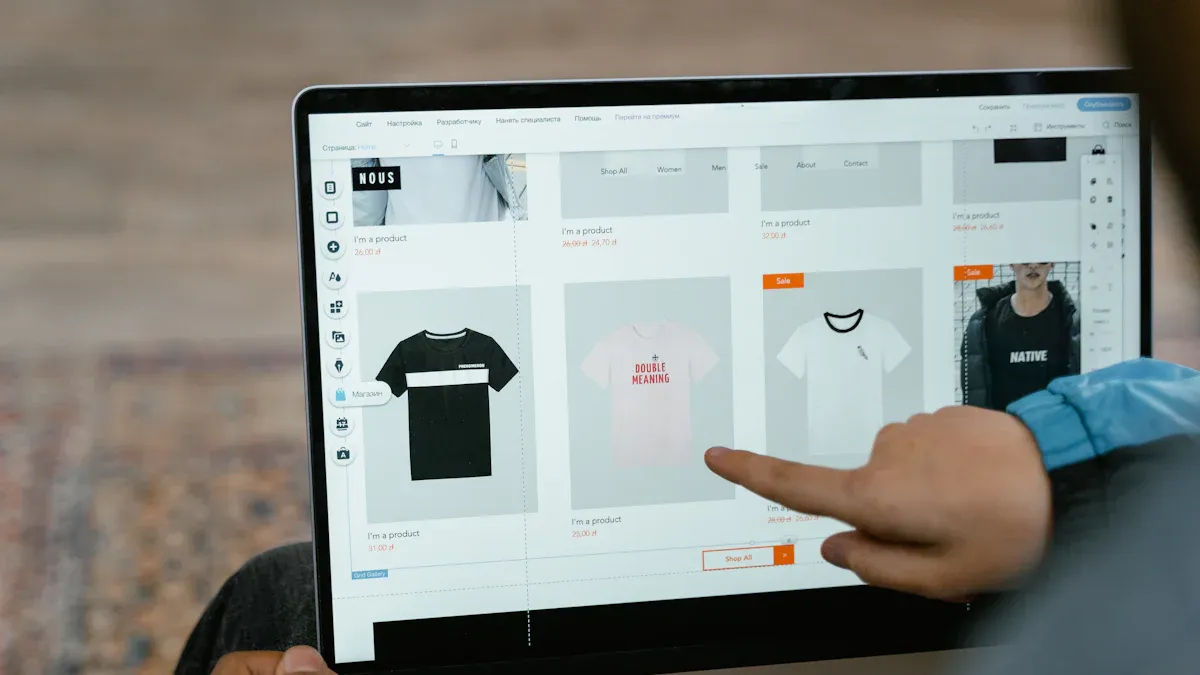How Need-Based Recommenders Beat “People Also Buy” Lists

When you shop online, have you noticed those "People Also Buy" lists? They’re like a one-size-fits-all suggestion box, showing items other shoppers added to their carts. But here's the thing—they don’t always match what you’re looking for. That’s where need-based recommenders come in. These smart tools focus on what you need right now, tailoring suggestions based on your preferences and intent.
Why does this matter? Personalization isn’t just a buzzword. It works. Did you know customers spend 38% more with brands that nail personalization? Plus, companies using these strategies see their revenue jump by up to 29%. Need-based recommenders make shopping easier and more relevant for you, leaving generic lists in the dust.
Key Takeaways
Need-based recommenders help you shop by learning what you like. They suggest items that fit your needs.
These tools make shopping easier by cutting choices and giving quick updates. This lowers stress and saves time.
Businesses gain more sales and money with need-based recommenders. They show items that match what customers want.
Unlike 'People Also Buy' lists, which follow trends, need-based recommenders focus on what each person does. This gives better suggestions.
Using need-based recommenders helps businesses grow. They make customers happy and build strong connections.
Understanding Need-Based Recommenders

How They Work
Need-based recommenders focus on understanding what you’re looking for at the moment. They don’t just guess based on what others bought. Instead, they analyze your behavior, preferences, and intent to deliver suggestions that actually make sense for you.
Here’s how they do it:
Decision Support Metrics: These systems use metrics like Precision@k and Recall@k to ensure the recommendations are relevant to your needs.
Business Metrics: They rely on A/B testing to measure success. Metrics like click-through rates (CTR) and adoption rates show how well users respond to the suggestions.
Architectural Paradigms: The system combines offline and online processing. Offline, it trains models using large datasets. Online, it works in real time to provide instant recommendations when you need them.
Think of it as a personal shopping assistant that learns from your actions and adjusts its advice to match your current goals. Whether you’re browsing for a gift or upgrading your tech, these systems aim to make your search faster and more relevant.
Real-World Examples
You’ve probably already seen need-based recommenders in action. Ever noticed how Netflix suggests shows based on what you’ve watched? That’s a perfect example. It doesn’t just show you what’s popular. It looks at your viewing history and recommends titles you’re likely to enjoy.
E-commerce platforms like Amazon also use these systems. If you’re shopping for a camera, they might suggest lenses or tripods that match the model you’re considering. These aren’t random picks—they’re tailored to your specific needs.
Even grocery delivery apps use this approach. If you add pasta to your cart, they might suggest sauce or cheese to complete your meal. It’s all about making your experience smoother and more personalized.
The Limitations of "People Also Buy" Lists
How They Operate
"People Also Buy" lists rely on patterns from past purchases. They look at what other customers bought alongside the item you're viewing and suggest those products to you. It’s like a digital version of peer pressure—if others bought it, maybe you should too.
These lists are powered by simple algorithms. They don’t analyze your preferences or behavior. Instead, they group products based on popularity or purchase frequency. For example, if someone buys a laptop, the system might suggest a mouse or a laptop bag because those items are commonly purchased together.
While this approach seems logical, it’s not very smart. It assumes that everyone shopping for the same item has the same needs. That’s where the cracks start to show.
Why They Fall Short
Here’s the problem: "People Also Buy" lists don’t know you. They don’t understand why you’re shopping or what you’re looking for. This lack of context makes their suggestions feel random or irrelevant.
Imagine you’re buying a gift for a friend. You click on a book, and the list shows you other books people bought. But what if your friend already owns those? Or worse, what if they’re not even interested in that genre? The recommendations miss the mark because they don’t consider your intent.
Tip: Generic suggestions can frustrate users and lead to decision fatigue. When the options don’t align with your needs, you’re more likely to abandon your cart.
Another issue is over-reliance on trends. Just because an item is popular doesn’t mean it’s right for you. These lists often push bestsellers, ignoring niche or personalized options that might suit you better.
In short, "People Also Buy" lists are like a one-size-fits-all solution in a world that craves customization. They lack the depth and flexibility to truly enhance your shopping experience.
Why Need-Based Recommenders Excel
Personalization and Relevance
Let’s face it—shopping feels better when it’s tailored to you. Need-based recommenders shine because they focus on your unique preferences and intent. Instead of throwing random suggestions your way, they dig into what you’re actually looking for.
Imagine you’re searching for a new pair of running shoes. A need-based recommender doesn’t just show you popular options. It considers your size, style preferences, and even the type of running you do. Are you a trail runner? A casual jogger? These systems know the difference and adjust their recommendations accordingly.
This level of personalization makes the experience feel less like a guessing game and more like a curated journey. You’re not just another shopper in the crowd. The system treats you like an individual, offering products that truly match your needs.
Note: Personalization isn’t just a nice-to-have—it’s a game-changer. Studies show that 80% of consumers are more likely to buy from brands that offer personalized experiences.
Improved User Experience
Have you ever felt overwhelmed by too many choices? Need-based recommenders simplify things. They cut through the noise and present options that make sense for you. This creates a smoother, more enjoyable shopping experience.
For example, instead of scrolling through hundreds of items, you get a shortlist of products that fit your criteria. It’s like having a personal assistant who knows exactly what you want. This saves you time and reduces frustration.
Plus, these systems adapt in real time. If you change your search or add something to your cart, the recommendations update instantly. This dynamic approach keeps the experience fresh and relevant. You’re not stuck with outdated suggestions that no longer apply.
Tip: A better user experience doesn’t just make you happy—it builds trust. When you feel understood, you’re more likely to return to the same platform for future purchases.
Boosting Conversion Rates
Here’s the kicker: need-based recommenders don’t just make shopping easier—they also drive results for businesses. By offering relevant suggestions, they increase the chances that you’ll find something you love and actually buy it.
Think about it. If you’re shown products that align with your needs, you’re more likely to click “Add to Cart.” This targeted approach leads to higher conversion rates. Businesses see more sales, and you get exactly what you’re looking for. It’s a win-win.
Need-based recommenders also reduce cart abandonment. When the recommendations feel spot-on, you’re less likely to second-guess your choices. This creates a smoother path from browsing to checkout.
Fun Fact: Companies using advanced recommendation systems report up to a 30% increase in revenue. That’s the power of getting it right.
In short, need-based recommenders excel because they prioritize you. They make shopping personal, enjoyable, and effective. Whether you’re buying groceries, gadgets, or gifts, these systems ensure you find what you need without the hassle.
Applications of Need-Based Recommenders

E-commerce Use Cases
When you shop online, have you noticed how some platforms seem to know exactly what you need? That’s the magic of need-based recommenders. These systems transform your shopping experience by offering suggestions that feel tailor-made for you. Whether you're searching for a new outfit or upgrading your home gadgets, they make the process faster and more enjoyable.
Here’s how they shine in e-commerce:
Personalized Product Suggestions: Instead of showing you random items, these recommenders analyze your preferences. For example, if you’re browsing for a smartphone, they might suggest accessories like cases or screen protectors that match your chosen model.
Dynamic Updates: As you explore different products, the recommendations adjust in real time. This ensures you always see options that align with your current interests.
Cross-Selling Opportunities: Need-based recommenders don’t just help you find what you’re looking for—they also introduce you to complementary products. If you’re buying a coffee maker, they might suggest premium coffee beans or a grinder to enhance your experience.
E-commerce platforms like Amazon and Walmart have mastered this approach. By focusing on your needs, they create a seamless shopping journey that keeps you coming back for more.
Fun Fact: Businesses using advanced recommendation systems in e-commerce report up to a 30% increase in revenue. That’s the power of personalization in action.
Applications in Other Industries
Need-based recommenders aren’t just for shopping. They’re making waves in other industries too, helping businesses deliver better experiences and achieve impressive results. Let’s take a closer look at how they’re being used:
Industry | How They Make a Difference |
|---|---|
E-commerce | Enhance the shopping experience and boost sales with personalized product suggestions. |
OTT Platforms | Suggest content based on your preferences, keeping you engaged and entertained. |
BFSI Sector | Recommend financial products tailored to your needs, improving satisfaction and loyalty. |
Take OTT platforms like Netflix or Hulu, for instance. They use need-based recommenders to suggest shows and movies you’ll love based on your viewing history. This keeps you hooked and ensures you never run out of things to watch.
In the BFSI (Banking, Financial Services, and Insurance) sector, these systems are game-changers. Imagine logging into your banking app and seeing personalized investment options or credit card offers that match your financial goals. It’s like having a financial advisor at your fingertips.
Tip: Need-based recommenders don’t just improve user experiences—they also drive measurable business outcomes. Companies see faster service times, higher customer satisfaction, and significant cost savings after implementing these systems.
Here’s a quick snapshot of the impact:
Metric | Before Implementation | After Implementation | Change |
|---|---|---|---|
Average Handle Time | N/A | Faster service | |
Customer Satisfaction Score | N/A | Slight improvement | Increased satisfaction |
Cost Savings | N/A | Millions saved | Streamlined process |
These examples show how need-based recommenders go beyond e-commerce to revolutionize industries. They’re not just tools—they’re solutions that make life easier for you and more profitable for businesses.
Need-based recommenders clearly outshine "People Also Buy" lists. They focus on what matters most—your unique needs and preferences. By delivering personalized suggestions, they make shopping faster, easier, and more enjoyable.
Why it matters: Personalization isn’t just a trend. It’s the key to creating meaningful connections with customers.
If you’re a business, it’s time to rethink your strategy. Adopting need-based recommenders can boost sales, improve customer satisfaction, and keep users coming back. Why settle for generic when you can offer tailored experiences that truly resonate?
FAQ
What makes need-based recommenders different from "People Also Buy" lists?
Need-based recommenders focus on your preferences and intent. They analyze your behavior to suggest items that match your needs. "People Also Buy" lists rely on general trends, offering suggestions based on what others purchased, which often feels less relevant.
Can small businesses use need-based recommenders?
Absolutely! Many platforms offer scalable recommendation tools. These systems can help small businesses personalize customer experiences, boost sales, and compete with larger brands. You don’t need a massive budget to get started.
Do need-based recommenders work in real time?
Yes, they do! These systems update recommendations instantly based on your actions, like adding items to your cart or changing your search. This ensures you always see suggestions that match your current needs.
Are need-based recommenders hard to implement?
Not at all! Many solutions are plug-and-play, requiring minimal technical expertise. If you’re using an e-commerce platform, chances are it already supports recommendation tools you can customize.
How do need-based recommenders improve customer satisfaction?
They make shopping easier by showing you relevant options. You spend less time searching and more time finding what you need. This personalized experience builds trust and keeps you coming back.
See Also
Effective Strategies for Retail Demand Forecasting Each Week
How TikTok’s Content Graph Drives Retail Success
Impact of Weather Changes on Demand: Category Insights
Understanding Short-Term Demand Forecasting: Techniques and Challenges
Exploring Key Differences Between Omnichannel and Multichannel Approaches
